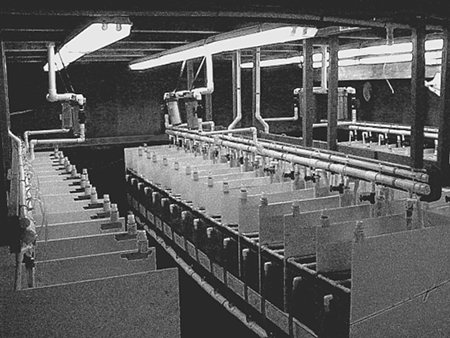Satisfactory fish growth with diets with up to 40 percent inclusion

Aquaculture feed manufacturers have a genuine interest in the use of plant proteins. Reflecting this interest, soybean meal has become a major aquatic feed ingredient. Cottonseed meal is a lower-cost protein alternative to soybean meal, but its use in commercial shrimp feeds may be limited because it contains gossypol and has low available lysine content.
Through a grant from the United States Department of Agriculture’s Agricultural Research Service, the authors studied replacement of soybean meal with mechanically extracted and solvent-extracted cottonseed meal.
Experimental feeds
Tested feeds contained 10, 20 and 30 percent cottonseed meal by weight in the two extracted forms (Table 1). Inclusion levels of 26 percent fishmeal and 5 percent shrimp meal were held constant for all feeds.
Soybean meal and wheat flour content was manipulated to maintain isonitrogenous feeds. A feed without cottonseed meal served as a control. Average proximate analysis, and total and free gossypol content of feeds is presented in Table 2.
Divakaran, Ingredient composition (percentage as fed) for feeds, Table 1
| Ingredient | Control | ME-10 | ME-20 | ME-30 | SE-10 | SE-20 | SE-30 |
|---|
Ingredient | Control | ME-10 | ME-20 | ME-30 | SE-10 | SE-20 | SE-30 |
|---|---|---|---|---|---|---|---|
| Cottonseed meal | 0.0 | 10.0 | 20.0 | 30.0 | 10.0 | 20.0 | 30.0 |
| Soybean meal | 22.7 | 13.9 | 5.0 | 0.0 | 15.1 | 7.5 | 0.0 |
| Wheat flour | 20.2 | 19.7 | 19.2 | 2.7 | 18.9 | 17.6 | 16.1 |
| Corn starch | 0.0 | 0.0 | 0.0 | 11.2 | 0.0 | 0.0 | 0.2 |
| Fish oil | 4.0 | 5.6 | 5.8 | 6.4 | 5.1 | 5.2 | 5.7 |
| Cellufil | 7.0 | 5.2 | 4.5 | 4.6 | 5.1 | 4.1 | 3.1 |
| Diatomaceous earth | 5.2 | 4.7 | 4.7 | 4.3 | 4.9 | 4.9 | 4.1 |
Divakaran, Proximate feed composition (percent dry matter), Table 2
| Control | ME-10 | ME-20 | ME-30 | SE-10 | SE-20 | SE-30 |
|---|
Control | ME-10 | ME-20 | ME-30 | SE-10 | SE-20 | SE-30 | |
|---|---|---|---|---|---|---|---|
| Crude protein | 37.7 | 38.1 | 40.1 | 38.3 | 40.4 | 39.0 | 40.9 |
| Ether extract | 9.0 | 10.2 | 10.1 | 12.2 | 11.7 | 11.3 | 12.0 |
| Intake energy | 3,974 | 4,245 | 4,321 | 4,352 | 4,303 | 4,333 | 4,427 |
| Total gossypol | 0 | 1,500 | 2,000 | 2,900 | 670 | 1,500 | 2,000 |
| Free gossypol | 0 | 250 | 120 | 110 | 90 | 100 | 100 |
Setup
The feeding trial was conducted in aerated glass aquariums with flow-through seawater. Litopenaeus vannamei shrimp of about 1.8 kg individual weight were stocked at 50 juveniles per square meter. Water temperature was maintained at 26.5±0.5 degrees-C, with salinity at 33±0.4 psu (practical salinity units; ocean water has a salinity of approximately 35 psu). Feed was provided to shrimp three times daily during 10 weeks. Five replicates per treatment were used.
Results
The cottonseed meal feeds yielded shrimp biological performance similar to that obtained with the soy-based control feed. Statistical analysis of the results did not detect significant differences among the feeds in terms of survival and weight gain. Specific growth rate was significantly higher only for the 30 percent solvent-extracted cottonseed meal feed compared to the control feed. Specifigrowth rate was 2.08 percent per day for the test feed and 1.88 percent per day for the control.
Conclusion
It appears cottonseed meal can be included in shrimp feeds as a replacement for soybean meal. This is in accordance with other studies that reported satisfactory fish growth when diets containing as high as 40 percent cottonseed meal were fed to fish. However, we found cottonseed meal difficult to blend into the feed mix to achieve uniform distribution.
(Editor’s Note: This article was originally published in the August 2002 print edition of the Global Aquaculture Advocate.)
Now that you've finished reading the article ...
… we hope you’ll consider supporting our mission to document the evolution of the global aquaculture industry and share our vast network of contributors’ expansive knowledge every week.
By becoming a Global Seafood Alliance member, you’re ensuring that all of the pre-competitive work we do through member benefits, resources and events can continue. Individual membership costs just $50 a year. GSA individual and corporate members receive complimentary access to a series of GOAL virtual events beginning in April. Join now.
Not a GSA member? Join us.
Authors
-
Subramaniam Divakaran, Ph.D.
The Oceanic Institute
41-202 Kalanianaole Highway
Waimanalo, Hawaii 96795 USA -
Mario Velasco, Ph.D.
Empacadora Nacional C.A.
Guayaquil, Ecuador
Tagged With
Related Posts

Intelligence
10 takeaways from GOAL 2019 in Chennai, India
The Global Aquaculture Alliance held its GOAL conference in Chennai, India, and recruited a host of experts in various fields to share their expertise.

Health & Welfare
A case for better shrimp nutrition
Shrimp farm performance can often be below realistic production standards. Use proven nutrition, feeds and feeding techniques to improve profitability.

Responsibility
A helping hand to lend: UK aquaculture seeks to broaden its horizons
Aquaculture is an essential contributor to the world food security challenge, and every stakeholder has a role to play in the sector’s evolution, delegates were told at the recent Aquaculture’s Global Outlook: Embracing Internationality seminar in Edinburgh, Scotland.

Health & Welfare
A holistic management approach to EMS
Early Mortality Syndrome has devastated farmed shrimp in Asia and Latin America. With better understanding of the pathogen and the development and improvement of novel strategies, shrimp farmers are now able to better manage the disease.


